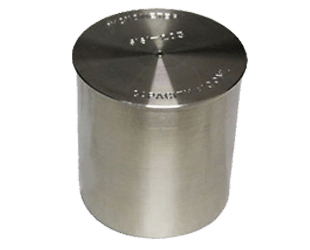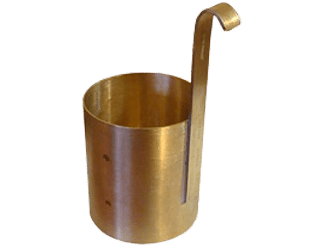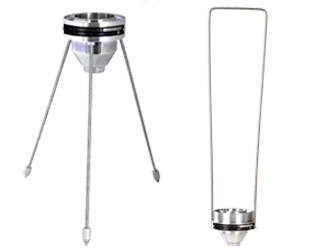DOWNLOAD
Density and viscosity cups
Density cup – Pycnometer
The method of measurement of the density consists in determining the mass of tested material, which is placed into a container (pycnometer) of known volume at a certain temperature. To calculate the density, the obtained weight has to be divided by volume of tested liquid.
The density cup (pycnometer) P-1 is compliant with ISO 2811-1.
Operation:
The tested material is poured into the pycnometer; after that, the cup is covered with a lid with overflow hole. Surpluses of fluid, which are flowing through overflow hole, have to be carefully removed with a soft material (if necessary, moistened with solvent).
The density of paint or other material is calculated by the formula:
ρ = (m2 – m0) / V
where
m0 = mass of empty pycnometer, g
m2 = mass of pycnometer with tested material, g
V = volume of pycnometer, cm3
Standard supply:
• Pycnometer
• Case
• Operating manual
Optional accessories:
• Other volumes of pycnometer on request
Viscosity mug
Viscosity dip mug VMS is used to determine the convectional viscosity of the dispersion polyvinyl-acetate homopolymers coarse dispersion.
The device is a cylindrical brass vessel with a handle and three orifices; two of them are located in the lateral wall of the cylinder (lateral orifices), and the third in the centre of the base (base orifice).
Operation:
The conventional viscosity, using the standard viscosity mug, has to be determined at (20 ± 2)°C. The dispersion needs to be thoroughly mixed and poured to full the mug. Than lift it and look at the level of the dispersion. When the dispersion level in the viscosity mug decreases and opens the upper lateral orifice, then start the stopwatch. The stopwatch has to be stopped at that moment when the dispersion comes to the level of the lower lateral orifice. The viscosity index is defined by the time (in seconds) that the dispersion takes to lower the level from the upper lateral orifice to the lower lateral orifice. The result of the test is the average value of three parallel testing (the discrepancy between of them should not exceed 10%).
Standard supply:
• Viscosity mug
• Case
• Operating manual
Optional accessories:
If user need the viscosity dip mug which is corresponds to other standards, please contact us before ordering to clarify the standard and sizes of orifices.
Viscosity flow cup
An important parameter of lubricants, paints and other liquids is viscosity. This parameter characterizes the ability of materials to resist the movement of one part relative to another. Viscosity flow cup VZ-246 is a device for determining the conditional viscosity of Newtonian fluids.
There is also a submersible type of viscosity flow cup, for express testing of hot liquids or monitoring the state of the liquid in operation.
Application:
It is used for rapid testing of the conditional viscosity of a large batch of products where it is necessary to evaluate viscosity as quickly as possible. It can also be used for liquids in use (oil baths of moving parts), hot liquids and others, where the use of the standard version of viscosity cup may be difficult.
Operation:
The method for determining the conditional viscosity using a viscosity flow cup is to measure the time the paint takes to expand through the nozzle of the tank. To do this, close the nozzle and fill the cup with paintwork material, then use the glass to remove excess (into a special groove in the upper part of the cup), so that exactly 100 cm3 of material will be in the tank. After opening the nozzle, the outflow of material will begin, it is important to measure the time from the beginning to the end of the expiration of the paint material. Knowing the expiration time of the material, it is possible to determine the conditional viscosity by empirical formulas, graphs and tables. For ease of use, the viscosity flow cup can be equipped with a special stand used for adjusting the level and height of the cup.
With the submersible viscosity flow cup VZ-246P the measurement is carried out by immersing the device into the material, and measuring the time of expiration of the material through a specific nozzle when the device is raised from the liquid. With this method, the measurement accuracy is degraded in comparison with the standard type of device, but the speed of testing is significantly increased.
Standard supply:
• Viscosity flow cup
• Nozzles: 2 mm, 4 mm, 6 mm
• Legs / handle
• Operating manual
Optional accessories:
• Viscosity cup is available in two models: on a tripod and a submersible type
• Viscosity flow cup also may be made from aluminium




